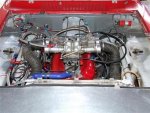That's when they were in race cars.
Now you can put TBI on these engines but won't get 160hp that way alone. Most I have seen is 150hp with porting, custom cam, tbi unit, headers, etc...
In the end, its cheaper and easier to do a v8 swap then do all of that to one.
Sent from my SGH-T499 using Tapatalk 2
In 2005 we got 212hp from a race-prepped carb'd 2.8. The heads were ported, but not that well. We used 1.75" intake and 1.50" exhaust valves, and they were probably a bit big for the heads, since the 2.8L heads just do not flow well, even after a lot of work. The cam was pretty radical, giving 0.517" valve lift with 1.6:1 roller rocker arms. The cam was advertised as providing power from 3500 to 7500 rpm, but the engine ran out of steam at 7100 rpm, again, probably because of the anemic heads. The engine did not mind spinning up to our 7200 rpm rev-limit, and it sounded great. The machine shop that did the work and dyno tuning noted that a Datsun 240-Z or 260-Z with a similar level of preparation would produce 270 - 280 hp. Again, the 2.8L heads seem to be the limiting factor.
I used a pair of Weber 45 DCOE carbs, but tuning the engine on a dyno we could only use 32mm chokes/venturii (and then tune the gas jets and air corrector jets to those chokes), again suggesting that the engine just would not breathe. The carbs were fitted to an Inglese 90-degree adapter that sat on a modified Offy 4-bbl intake manifold. The floor was removed from the Offy's top half, since for racing efforts that floor is a nasty restrictor plate. Because of the engine's narrow 60-degree configuration, the Offy manifold is a horror show as far as design and flow, but since it's the only aftermarket intake that fits the US market heads, it's all we had. Throttle bodies with the DCOE footprint could be used instead of carbs. Proper tuning would probably get a few more hp. On the exhaust side we used a decent but nothing-to-write-home-about header.
The bottom end was strengthened for integrity - forged flat top pistons that were still about 0.011" in the hole, so compression was not great; steel SBF rods narrowed at the big end to fit the V6 crank; and a 2.8L truck crank.
And, yes, that's a lot of effort for so little return. The few folks I know who have tried this - or claim that they have tried this - think that with properly ported and flow tested heads, 220 hp can be had in a pretty reliable race engine . . . that would last a season or two between (hopefully) minor rebuilds. And yes, a V8 swap makes a lot of sense in most situations.













